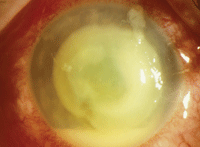 Q: In spite of significant advances in contact lens materials and solutions, several population-based studies have shown very little reduction in the rate of microbial keratitis in contact lens wearers over the past two decades. Why haven’t we been able to effectively reduce the number of new cases seen each year?
Q: In spite of significant advances in contact lens materials and solutions, several population-based studies have shown very little reduction in the rate of microbial keratitis in contact lens wearers over the past two decades. Why haven’t we been able to effectively reduce the number of new cases seen each year?
A: Although microbial keratitis is a relatively rare condition, it remains one of the most serious complications of contact lens wear. Epidemiologic studies over the past decade haven’t indicated much change in rates of microbial keratitis, but they have helped clinicians pinpoint significant risk factors for the disease.
“We may not have shifted the absolute number, but we do have some additional information about how we can limit severity,” says Fiona Stapleton, Ph.D., MCOptom, head of the School of Optometry and Vision Science at the University of New South Wales and senior research associate at the Brien Holden Vision Institute, Sydney, Australia. “We have gained some insight into how to lessen the impact of the microbial keratitis—avoiding a delay in getting appropriate treatment, proper storage case hygiene practice, and having the patient present back to the optometrist rather than a general practitioner.”
Researchers also have identified overnight wear and poor contact lens hygiene as the major risk factors.1 “In daily contact lens wear, we know contact lens storage case practice is paramount, particularly for severe disease—namely case replacement and cleaning,” Dr. Stapleton says. “If we can sort out those two, we can eliminate 60% of the disease load in daily wear.”2 She believes new innovations like antimicrobial lenses and cases could make a difference in the incidence of microbial keratitis, but says that products such as new lens types and solutions historically have not made a difference.
Many optometrists believe daily disposable lenses could also be beneficial because they make it easier for patients to comply with their lens care routine. “We have seen that with daily disposables, there is a lower rate of severe disease—probably because there is a lower rate of those environmental organisms found in the storage case,” Dr. Stapleton says.

This contact lens wearer developed a Pseudomonas ulcer with a central ring infiltrate and hypopyon.
Robin Chalmers, O.D., an independent clinical trial consultant and adjunct professor at Indiana University School of Optometry, agrees that daily disposable lenses could be useful because there’s less chance of contamination from storage, everyday handling and reuse. In a recent study she conducted, daily disposable lenses were protective with a 12.5 times lower risk of inflammatory events compared with reusable daily wear lenses.3
“If we take that and make the assumption—and this is a bit of a leap—that inflammatory events are driven by the same bacterial bioburden on the lenses that infections are, I’m hoping that the microbial keratitis rate would be lower when more patients are using daily disposable lenses,” Dr. Chalmers says.
But to get definitive answers, she believes we need new studies incorporating more modern products. New data could provide a more accurate picture of the incidence of contact lens-related microbial keratitis today.
“I don’t think the population-based studies that were conducted about 10 years ago accurately reflect the current mix of lenses or care products,” Dr. Chalmers says. “Ten years ago, we found that there really wasn’t much change in the rate of microbial keratitis, and I would say that we just don’t know much about what has happened since then.”
1. Stapleton F, Keay LJ, Edwards K, et al. The incidence of contact lens-related microbial keratitis in Australia. Ophthalmology. 2008 Oct;115(10):1655-62.
2. Stapleton F, Edwards K, Keay L, et al. Risk factors for moderate and severe keratitis in daily wear contact lens users. Ophthalmology. 2012 Aug;119(8):1516-21.
3. Chalmers RL, Keay L, McNally J, Kern J. Multicenter case-control study of the role of lens materials and care products on the development of corneal infiltrates. Optom Vis Sci. 2012 Mar;89(3):316-25.

